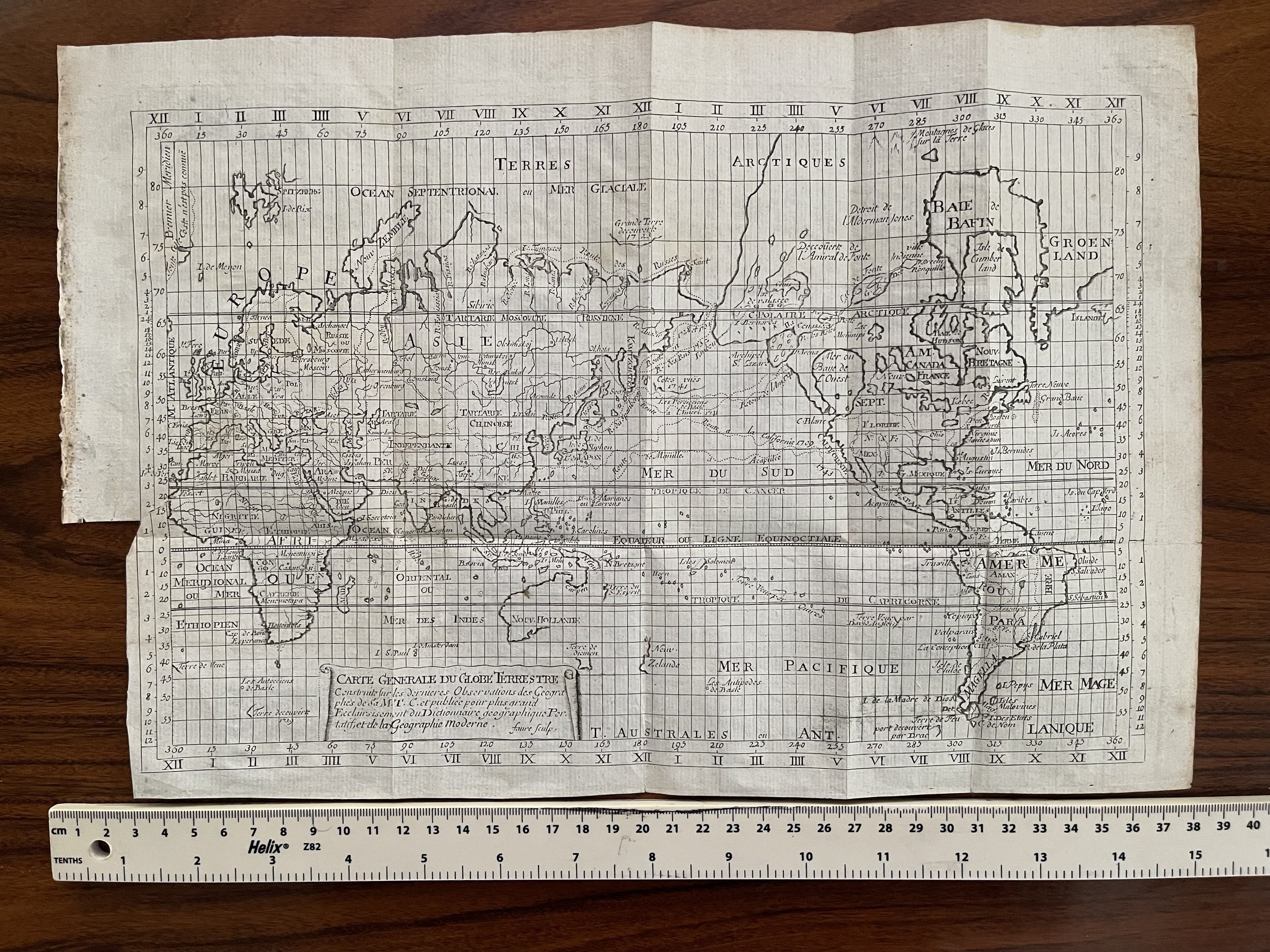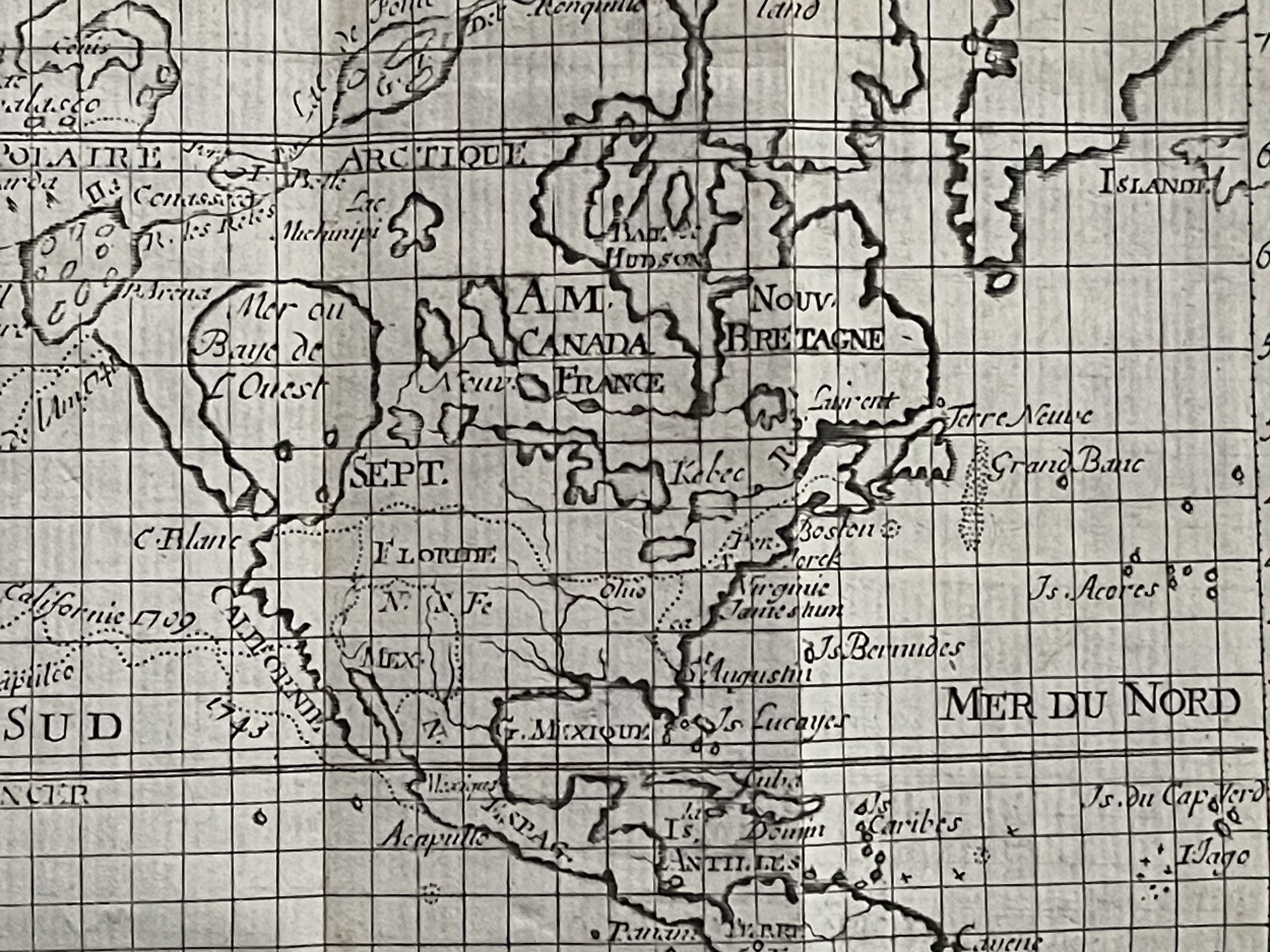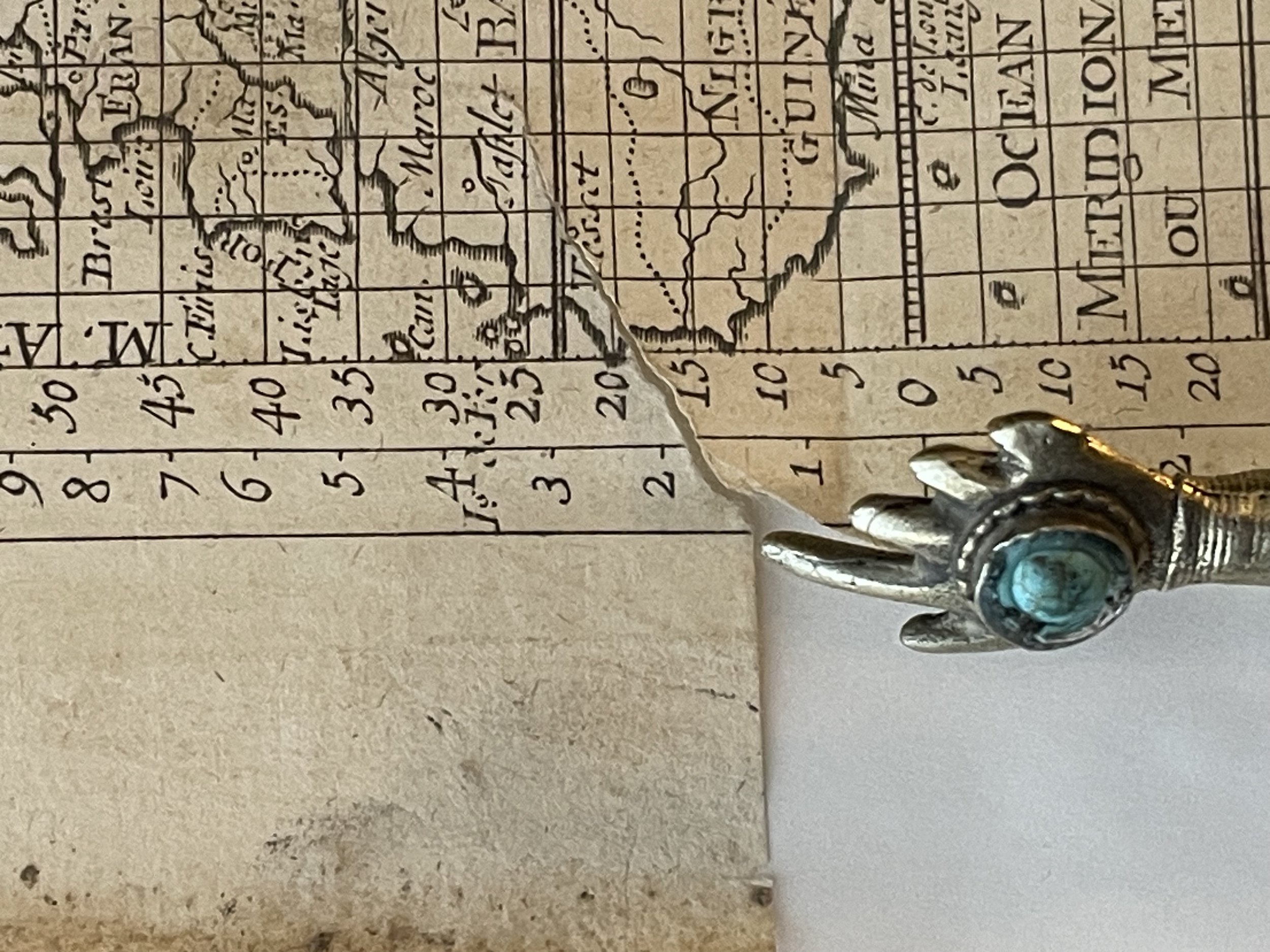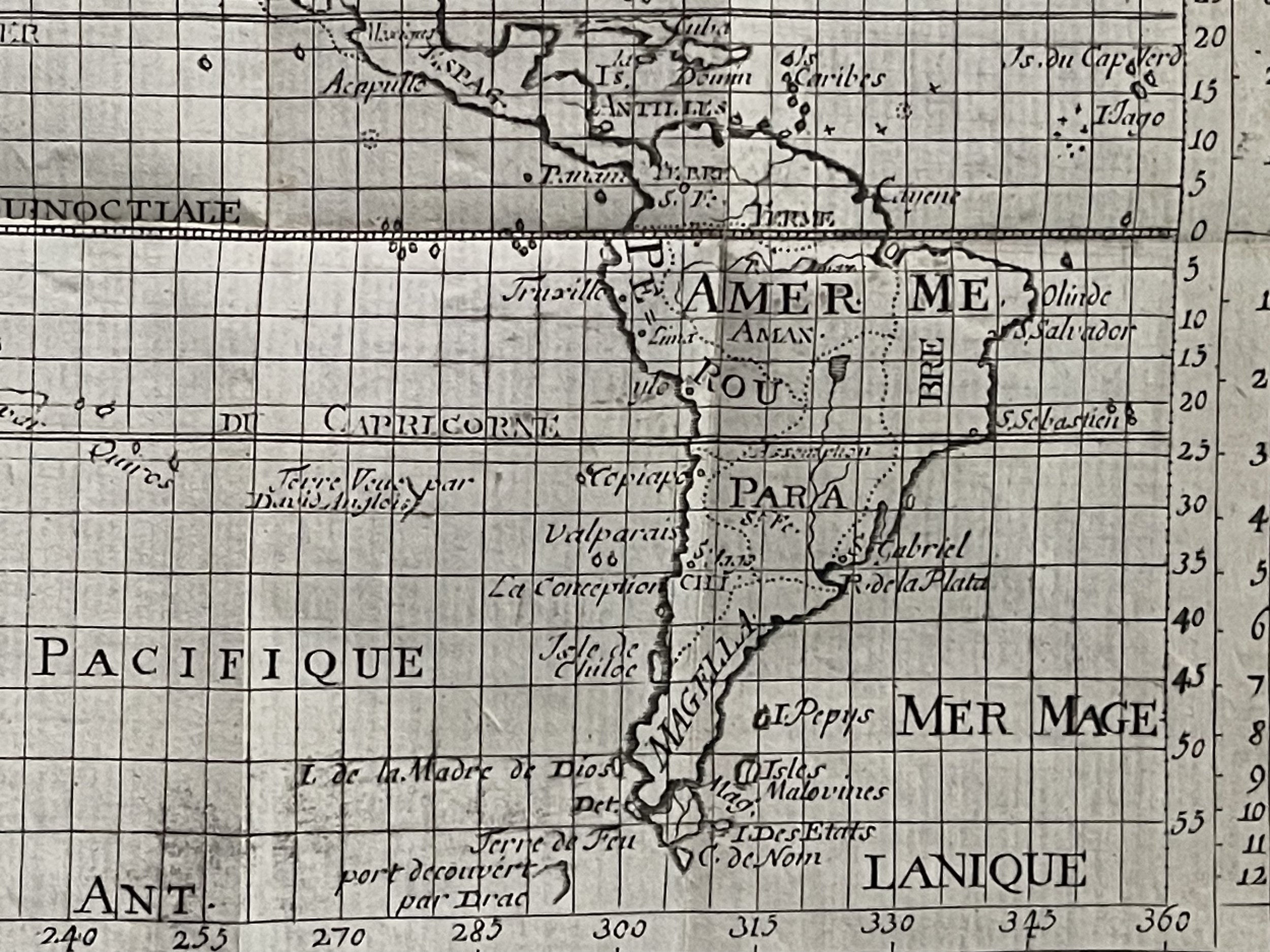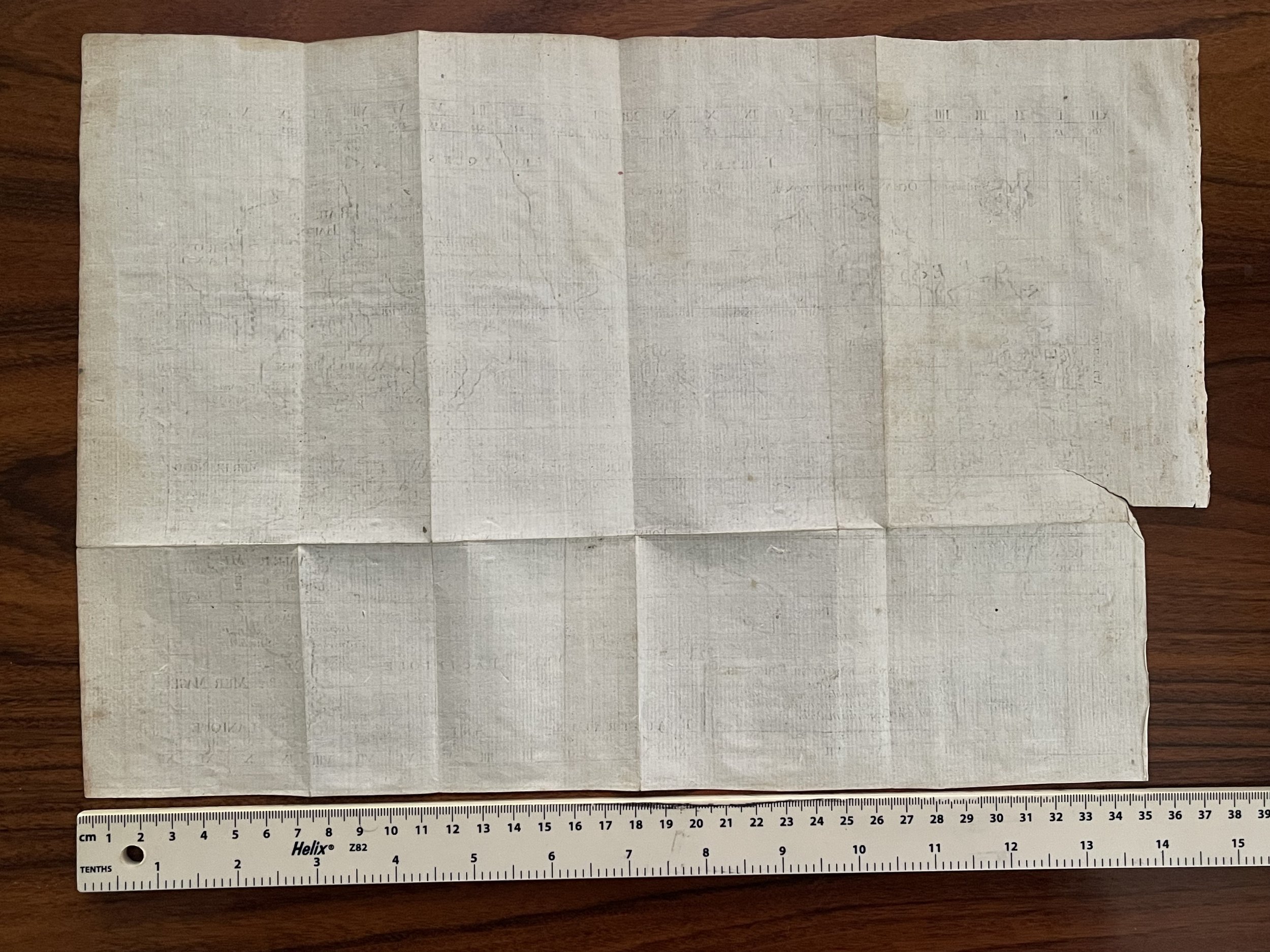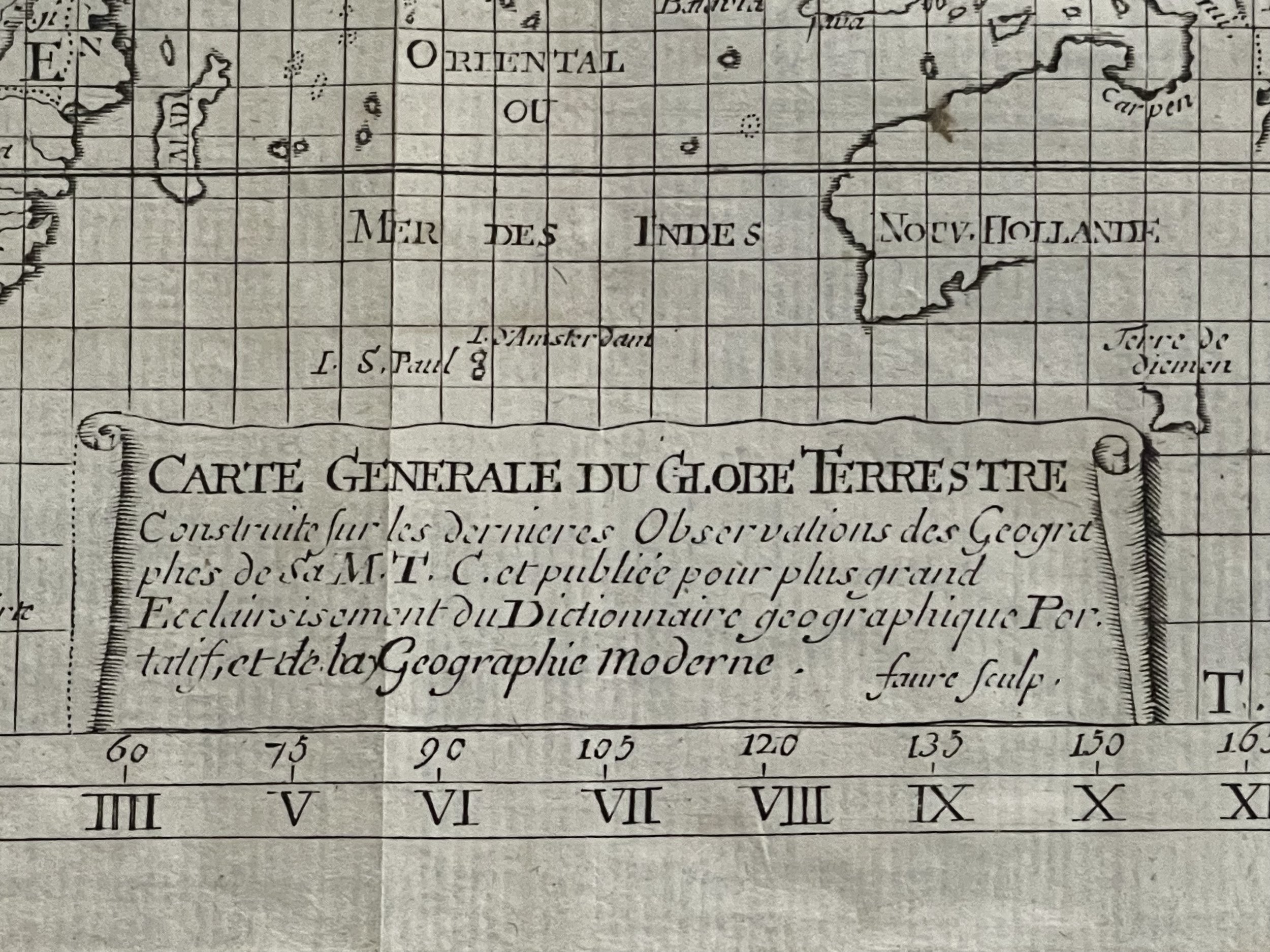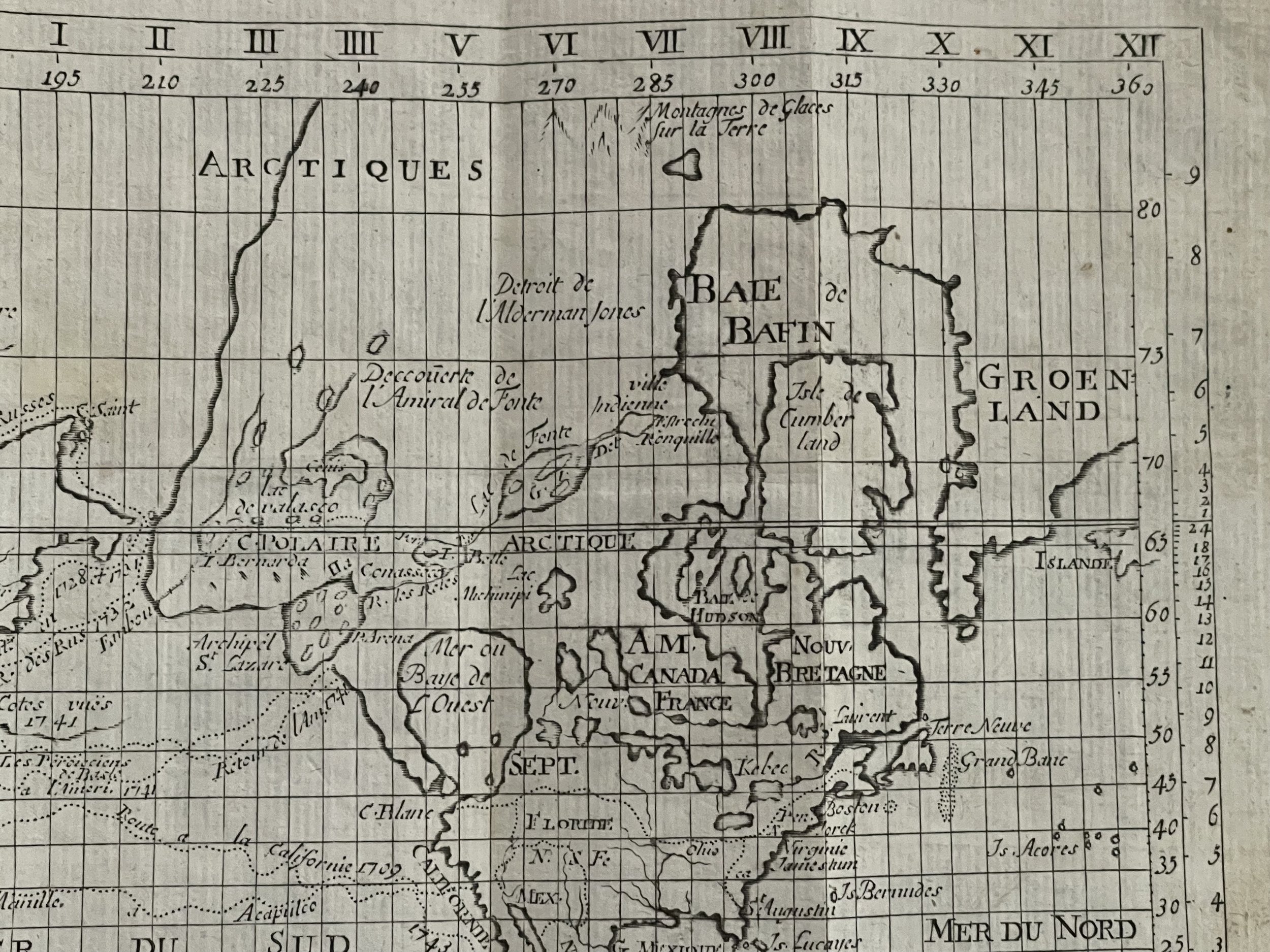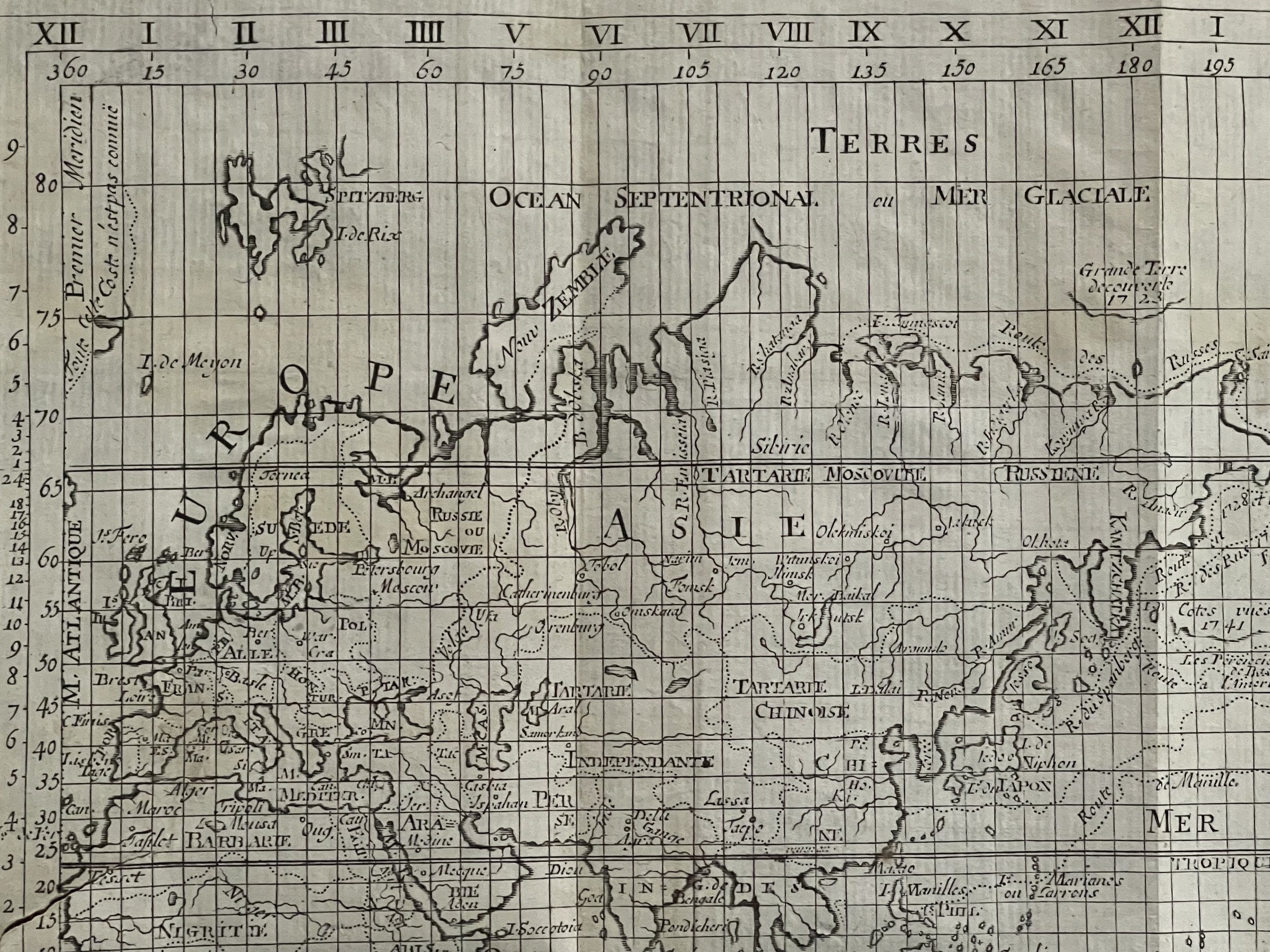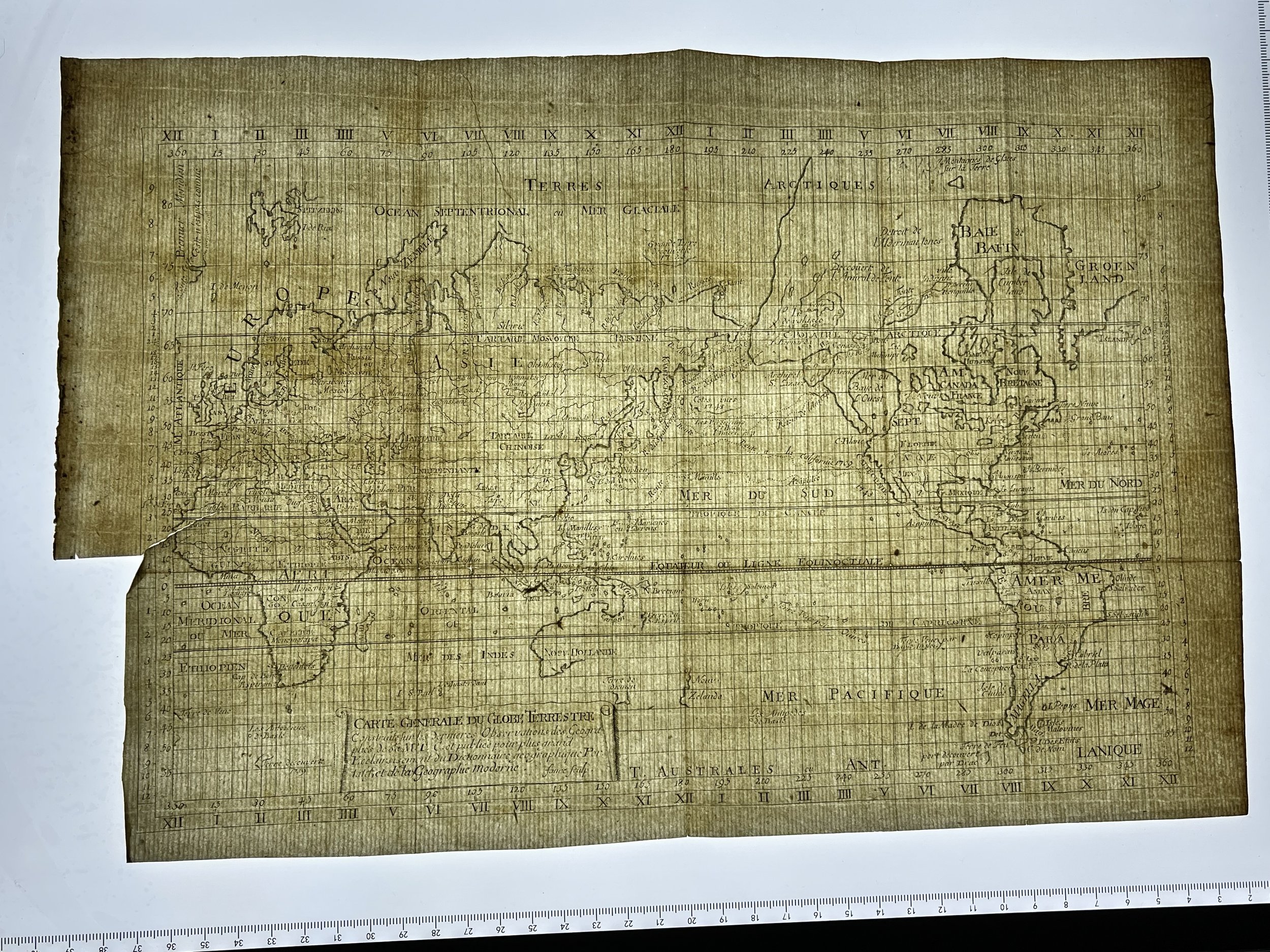Carte Generale du Globe Terrestre (Italian World Map) - REMONDINI Family - Italy 1761 - Very Scarce
Carte generale du globe terrestre construite & publiee par le S.r Jsaac Brouckner geographe de S.M.I.C. exaninee & approuvee. Tipografia REMONDINI (Bassano del Grappa 1650 circa - 1860)
Unusual and scarce world map by the Remondini family business, taken from Dizionario Geografico portatile. After Isaac Brouckner. Printed by Remondini, who was a famous publisher of prints and books all with a popular character. He flourished in Bassano in 1661 and his firm was active until 1860.
General Map of the Terrestrial Globe Built on the Latest Observations of Geographers of Its MTC and published for greater clarification of the Portable Geographic Dictionary, and of Modern Geography. Mercator projection map including the Northwest Passage and a large Western Sea. Attractive Italian world map presented in Mercator's projection and centered on Australia.
Featuring the voyage of Spanberg, among others in the years of 1709-1739. Greenland is shown connected to North America. According to the title the map was approved by Daniel Bernoulli (1700-1782), Dutch physician, physicist and mathematician, active in St. Petersburg and Switzerland.
Business founded by Giovanni Antonio Remondini (1634 - 1711), the house reached its peak in the second half of the eighteenth century, under the leadership of Joseph Remondini (1745 -1811).
Small tear to left neat line see pointer (pointer not in sale). I will repair this with Japanese paper before sending. Price and grading commensurate.
Giovanni Antonio Remondini was born in Padua in 1634 . In 1657 , in his early twenties, he moved into a house in the main square of Bassano. He opened a shop selling cloth, wool , silk and iron tools. Later he added to his ware’s woodcuts of saints and popular subjects, which farmers bought to protect their homes. The paper came from Verona, Treviso and Padua. Subsequently Remondini freed himself from his suppliers and developed his own printing house, purchasing an old press . From that first press originated one of the most important copperplate engravings in Europe .
To the brightly coloured prints, games were added, such as the goose chase or paper soldiers , and story books to satisfy the tastes of the common people. Giovanni Antonio established relationships with the wanderers of the poor Tesino valleys (a Trentino side valley of Valsugana ) and the Venetian Slovenians of Cividale del Friuli (called "Schiavoni"), organized them into companies (with a guide, or «company leader») and entrusted they sell the prints. Through their work the Remondinis managed to spread their brand in Europe.
In 1711 , upon the death of the founder, the assets were divided among the heirs and the printing business fell to his son Giuseppe and his descendants. Giuseppe gave a decisive development to the company, taking ownership, or at least control, of several paper mills: a factory was already active in 1725 in Oliero , another was in Vas , in the Treviso area, a third in Cogollo , in the Vicenza area. Between 1735 and 1739 Giuseppe Remondini (1700-1769) came into possession of three other paper mills, which from then on operated exclusively to supply paper to his printing press in Bassano. The Remondini printing house also produced other types such as wallpaper and many series of small prints to be glued onto furniture, to obtain the typical eighteenth-century Venetian decorations known as lacca povera or arte povera .
Joseph was also very skilled in dealing with political power. In 1738 he obtained, from the Magistrates of the V Savi at the Mercanzia of Venice, the exclusive privilege of free marketing of his religious prints throughout the national territory free of duties. In 1750 the Remondinis opened a bookshop in Venice , entering direct competition with the booksellers of the book capital. On their side they had the advantage of being the producers of the raw material used, namely paper. This allowed it to be placed on the national and international market at significantly lower costs than those charged by all other Venetian printers.
The printing house continued to print quality books and geographical atlases. Many talented engravers also worked there, including Abbot Paolo Santini, who was one of the main authors of the sacred images. Santini's collection was reprinted - in large and small editions - for a long time.
Production increased until it reached a planetary level. The old network of door-to-door salesmen was replaced by an efficient network of in-house distributors, organized by geographical areas. The Tesini travelled across Europe from Germany to the Nordic countries, and then went west towards the Americas; the Schiavoni, who were entrusted with the entire eastern part of the world, reached as far as the Pacific Ocean. With these two large distribution centres, the printing company's commercial network was able to reach four continents.
The decline began in the first half of the nineteenth century, after the Napoleonic invasions . At the beginning of the century the Remondini printing house had 18 presses for typographical and xylographic impressions, 24 for copper engravings , equipment for printing special papers and wallpapers , 4 paper mills and a foundry for lead characters , which produced employment for over 1,000 workers.
In 1840 production was still considerable, but unsold items were already accumulating. In 1848 the collapse began and in 1861 the company closed its doors.
Carte generale du globe terrestre construite & publiee par le S.r Jsaac Brouckner geographe de S.M.I.C. exaninee & approuvee. Tipografia REMONDINI (Bassano del Grappa 1650 circa - 1860)
Unusual and scarce world map by the Remondini family business, taken from Dizionario Geografico portatile. After Isaac Brouckner. Printed by Remondini, who was a famous publisher of prints and books all with a popular character. He flourished in Bassano in 1661 and his firm was active until 1860.
General Map of the Terrestrial Globe Built on the Latest Observations of Geographers of Its MTC and published for greater clarification of the Portable Geographic Dictionary, and of Modern Geography. Mercator projection map including the Northwest Passage and a large Western Sea. Attractive Italian world map presented in Mercator's projection and centered on Australia.
Featuring the voyage of Spanberg, among others in the years of 1709-1739. Greenland is shown connected to North America. According to the title the map was approved by Daniel Bernoulli (1700-1782), Dutch physician, physicist and mathematician, active in St. Petersburg and Switzerland.
Business founded by Giovanni Antonio Remondini (1634 - 1711), the house reached its peak in the second half of the eighteenth century, under the leadership of Joseph Remondini (1745 -1811).
Small tear to left neat line see pointer (pointer not in sale). I will repair this with Japanese paper before sending. Price and grading commensurate.
Giovanni Antonio Remondini was born in Padua in 1634 . In 1657 , in his early twenties, he moved into a house in the main square of Bassano. He opened a shop selling cloth, wool , silk and iron tools. Later he added to his ware’s woodcuts of saints and popular subjects, which farmers bought to protect their homes. The paper came from Verona, Treviso and Padua. Subsequently Remondini freed himself from his suppliers and developed his own printing house, purchasing an old press . From that first press originated one of the most important copperplate engravings in Europe .
To the brightly coloured prints, games were added, such as the goose chase or paper soldiers , and story books to satisfy the tastes of the common people. Giovanni Antonio established relationships with the wanderers of the poor Tesino valleys (a Trentino side valley of Valsugana ) and the Venetian Slovenians of Cividale del Friuli (called "Schiavoni"), organized them into companies (with a guide, or «company leader») and entrusted they sell the prints. Through their work the Remondinis managed to spread their brand in Europe.
In 1711 , upon the death of the founder, the assets were divided among the heirs and the printing business fell to his son Giuseppe and his descendants. Giuseppe gave a decisive development to the company, taking ownership, or at least control, of several paper mills: a factory was already active in 1725 in Oliero , another was in Vas , in the Treviso area, a third in Cogollo , in the Vicenza area. Between 1735 and 1739 Giuseppe Remondini (1700-1769) came into possession of three other paper mills, which from then on operated exclusively to supply paper to his printing press in Bassano. The Remondini printing house also produced other types such as wallpaper and many series of small prints to be glued onto furniture, to obtain the typical eighteenth-century Venetian decorations known as lacca povera or arte povera .
Joseph was also very skilled in dealing with political power. In 1738 he obtained, from the Magistrates of the V Savi at the Mercanzia of Venice, the exclusive privilege of free marketing of his religious prints throughout the national territory free of duties. In 1750 the Remondinis opened a bookshop in Venice , entering direct competition with the booksellers of the book capital. On their side they had the advantage of being the producers of the raw material used, namely paper. This allowed it to be placed on the national and international market at significantly lower costs than those charged by all other Venetian printers.
The printing house continued to print quality books and geographical atlases. Many talented engravers also worked there, including Abbot Paolo Santini, who was one of the main authors of the sacred images. Santini's collection was reprinted - in large and small editions - for a long time.
Production increased until it reached a planetary level. The old network of door-to-door salesmen was replaced by an efficient network of in-house distributors, organized by geographical areas. The Tesini travelled across Europe from Germany to the Nordic countries, and then went west towards the Americas; the Schiavoni, who were entrusted with the entire eastern part of the world, reached as far as the Pacific Ocean. With these two large distribution centres, the printing company's commercial network was able to reach four continents.
The decline began in the first half of the nineteenth century, after the Napoleonic invasions . At the beginning of the century the Remondini printing house had 18 presses for typographical and xylographic impressions, 24 for copper engravings , equipment for printing special papers and wallpapers , 4 paper mills and a foundry for lead characters , which produced employment for over 1,000 workers.
In 1840 production was still considerable, but unsold items were already accumulating. In 1848 the collapse began and in 1861 the company closed its doors.
Carte generale du globe terrestre construite & publiee par le S.r Jsaac Brouckner geographe de S.M.I.C. exaninee & approuvee. Tipografia REMONDINI (Bassano del Grappa 1650 circa - 1860)
Unusual and scarce world map by the Remondini family business, taken from Dizionario Geografico portatile. After Isaac Brouckner. Printed by Remondini, who was a famous publisher of prints and books all with a popular character. He flourished in Bassano in 1661 and his firm was active until 1860.
General Map of the Terrestrial Globe Built on the Latest Observations of Geographers of Its MTC and published for greater clarification of the Portable Geographic Dictionary, and of Modern Geography. Mercator projection map including the Northwest Passage and a large Western Sea. Attractive Italian world map presented in Mercator's projection and centered on Australia.
Featuring the voyage of Spanberg, among others in the years of 1709-1739. Greenland is shown connected to North America. According to the title the map was approved by Daniel Bernoulli (1700-1782), Dutch physician, physicist and mathematician, active in St. Petersburg and Switzerland.
Business founded by Giovanni Antonio Remondini (1634 - 1711), the house reached its peak in the second half of the eighteenth century, under the leadership of Joseph Remondini (1745 -1811).
Small tear to left neat line see pointer (pointer not in sale). I will repair this with Japanese paper before sending. Price and grading commensurate.
Giovanni Antonio Remondini was born in Padua in 1634 . In 1657 , in his early twenties, he moved into a house in the main square of Bassano. He opened a shop selling cloth, wool , silk and iron tools. Later he added to his ware’s woodcuts of saints and popular subjects, which farmers bought to protect their homes. The paper came from Verona, Treviso and Padua. Subsequently Remondini freed himself from his suppliers and developed his own printing house, purchasing an old press . From that first press originated one of the most important copperplate engravings in Europe .
To the brightly coloured prints, games were added, such as the goose chase or paper soldiers , and story books to satisfy the tastes of the common people. Giovanni Antonio established relationships with the wanderers of the poor Tesino valleys (a Trentino side valley of Valsugana ) and the Venetian Slovenians of Cividale del Friuli (called "Schiavoni"), organized them into companies (with a guide, or «company leader») and entrusted they sell the prints. Through their work the Remondinis managed to spread their brand in Europe.
In 1711 , upon the death of the founder, the assets were divided among the heirs and the printing business fell to his son Giuseppe and his descendants. Giuseppe gave a decisive development to the company, taking ownership, or at least control, of several paper mills: a factory was already active in 1725 in Oliero , another was in Vas , in the Treviso area, a third in Cogollo , in the Vicenza area. Between 1735 and 1739 Giuseppe Remondini (1700-1769) came into possession of three other paper mills, which from then on operated exclusively to supply paper to his printing press in Bassano. The Remondini printing house also produced other types such as wallpaper and many series of small prints to be glued onto furniture, to obtain the typical eighteenth-century Venetian decorations known as lacca povera or arte povera .
Joseph was also very skilled in dealing with political power. In 1738 he obtained, from the Magistrates of the V Savi at the Mercanzia of Venice, the exclusive privilege of free marketing of his religious prints throughout the national territory free of duties. In 1750 the Remondinis opened a bookshop in Venice , entering direct competition with the booksellers of the book capital. On their side they had the advantage of being the producers of the raw material used, namely paper. This allowed it to be placed on the national and international market at significantly lower costs than those charged by all other Venetian printers.
The printing house continued to print quality books and geographical atlases. Many talented engravers also worked there, including Abbot Paolo Santini, who was one of the main authors of the sacred images. Santini's collection was reprinted - in large and small editions - for a long time.
Production increased until it reached a planetary level. The old network of door-to-door salesmen was replaced by an efficient network of in-house distributors, organized by geographical areas. The Tesini travelled across Europe from Germany to the Nordic countries, and then went west towards the Americas; the Schiavoni, who were entrusted with the entire eastern part of the world, reached as far as the Pacific Ocean. With these two large distribution centres, the printing company's commercial network was able to reach four continents.
The decline began in the first half of the nineteenth century, after the Napoleonic invasions . At the beginning of the century the Remondini printing house had 18 presses for typographical and xylographic impressions, 24 for copper engravings , equipment for printing special papers and wallpapers , 4 paper mills and a foundry for lead characters , which produced employment for over 1,000 workers.
In 1840 production was still considerable, but unsold items were already accumulating. In 1848 the collapse began and in 1861 the company closed its doors.
Code : A1046
Cartographer : Cartographer / Engraver / Publisher: Remondini
Date : Publication Place / Date - 1761
Size : Sheet size: Image Size: 25 x 37 cm
Availability : Available
Type - Genuine - Antique
Grading A-
Where Applicable - Folds as issued. Light box photo shows the folio leaf centre margin hinge ‘glue’, this is not visible otherwise.
Tracked postage, in casement. Please contact me for postal quotation outside of the UK.
